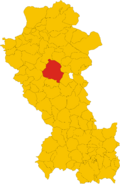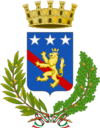Potenza facts for kids
Quick facts for kids
Potenza
Putenz(a) (Neapolitan)
|
|||
|---|---|---|---|
| Città di Potenza | |||

Left: A view of Mario Pagano Square, Stabile Theater, Potenza Province Office, Musmeci Bridge, Right: Potenza San Gerardo Cathedral, Reale Palace, San Gerardo Temple (from top to bottom)
|
|||
|
|||

Potenza within the Province of Potenza
|
|||
| Country | Italy | ||
| Region | Basilicata | ||
| Province | Potenza (PZ) | ||
| Area | |||
| • Total | 173 km2 (67 sq mi) | ||
| Elevation | 819 m (2,687 ft) | ||
| Population
(2023 estimate)
|
|||
| • Total | 64,406 | ||
| • Density | 372.3/km2 (964.2/sq mi) | ||
| Demonym(s) | Potentini | ||
| Time zone | UTC+1 (CET) | ||
| • Summer (DST) | UTC+2 (CEST) | ||
| Postal code |
85100
|
||
| Dialing code | 0971 | ||
| Patron saint | St. Gerard | ||
| Saint day | May 30 | ||
Potenza is a city in Southern Italy. It is the capital of the Basilicata region, which used to be called Lucania. Potenza is special because it's the highest regional capital in Italy. It sits high up in the Apennine Mountains, looking over the Basento river valley.
Contents
A Look at Potenza's Past
How Potenza Began
The first settlement of Potenza, originally called Potentia, was probably located about 10 kilometers (6 miles) south of where the city is today. The people of Potentia, called Lucanians, fought against Rome's enemies during wars with the Samnites and Bruttii. Rome took control of Potentia in the 4th century BC.
However, after Rome lost a big battle at Cannae in 216 BC, the people of Potentia rebelled. But Rome soon won another important battle, and Potentia was taken back. It became a military colony under Roman rule.
Potenza in the Middle Ages
In the 6th century, the city came under the control of the Lombards. For a while, Saracen raiders attacked the city. This stopped when the Norman conquest of southern Italy brought peace to the area.
By the 12th century, Potenza became an important religious center with its own bishop. In 1137, a Pope and an Emperor visited the city. Later, in 1148 or 1149, King Roger II of Sicily hosted King Louis VII of France in Potenza.
The city faced tough times. Emperor Frederick II attacked it. Then, because Potenza stayed loyal to his enemies, Charles I almost completely destroyed it. An earthquake in 1273 caused even more damage.
Potenza in Modern Times
After the Middle Ages, different noble families owned Potenza. During the time when Spain ruled Italy, the people of Potenza protested against the Spanish. In 1694, another big earthquake nearly destroyed the city again.
In 1799, Potenza was one of the first cities to rebel when the Neapolitan Republic was declared. The French army took control in 1806 and made Potenza the capital of Basilicata. King Joachim Murat worked to improve the city.
In 1848, another revolt happened but was stopped. Then, in 1857, a third major earthquake hit. Potenza rebelled one last time in 1860, just before Garibaldi's army helped unite Italy.
During World War II, in September 1943, the city was heavily bombed by the Allies. In 1980, Potenza was hit by another strong earthquake.
What to See in Potenza
Potenza has many interesting places to visit, showing its long history:
- Potenza Cathedral: This church, also known as the Duomo di San Gerardo, was updated in the 1700s. You can still see parts from the original 12th-century building, like a beautiful rose window.
- San Francesco Church: This church was built in 1274. Its entrance and bell tower are from the 1400s. Inside, you can find old tombs and a special painting of the Madonna from the 13th century.
- Torre Guevara: This tower is the last part of an old castle. Today, it's used for art shows.
- Palazzo Loffredo: This grand building from the 1600s was once a noble home. Now, it holds the National Archaeological Museum of Basilicata. The museum is named after archaeologist Dinu Adameșteanu.
- Old City Gates: While the old city walls are gone, three of their gates remain: Porta San Giovanni, Porta San Luca, and Porta San Gerardo.
- San Michele Church: This church was built in the 11th or 12th century in the Romanesque style.
- Santa Maria del Sepolcro Church: Another historic church in the city.
- Roman Villa Ruins: You can see the remains of an ancient Roman house in the Poggio Tre Galli area.
- Musmeci Bridge: This is a very unique and modern bridge, considered an important example of civil engineering.
Potenza's Location and Weather
Potenza's Climate
Potenza has an oceanic climate, which means it gets rain throughout the year. Summers are warm, and winters are cool.
| Climate data for Potenza | |||||||||||||
|---|---|---|---|---|---|---|---|---|---|---|---|---|---|
| Month | Jan | Feb | Mar | Apr | May | Jun | Jul | Aug | Sep | Oct | Nov | Dec | Year |
| Record high °C (°F) | 20.0 (68.0) |
21.8 (71.2) |
23.6 (74.5) |
25.6 (78.1) |
29.8 (85.6) |
33.0 (91.4) |
36.8 (98.2) |
36.8 (98.2) |
33.2 (91.8) |
30.0 (86.0) |
21.8 (71.2) |
20.0 (68.0) |
36.8 (98.2) |
| Mean daily maximum °C (°F) | 6.9 (44.4) |
7.2 (45.0) |
9.7 (49.5) |
12.8 (55.0) |
18.1 (64.6) |
22.3 (72.1) |
25.7 (78.3) |
25.8 (78.4) |
21.7 (71.1) |
16.5 (61.7) |
11.0 (51.8) |
7.9 (46.2) |
15.5 (59.8) |
| Daily mean °C (°F) | 4.0 (39.2) |
4.1 (39.4) |
6.1 (43.0) |
8.8 (47.8) |
13.7 (56.7) |
17.5 (63.5) |
20.6 (69.1) |
20.7 (69.3) |
17.2 (63.0) |
12.7 (54.9) |
7.9 (46.2) |
5.1 (41.2) |
11.5 (52.8) |
| Mean daily minimum °C (°F) | 1.2 (34.2) |
1.1 (34.0) |
2.5 (36.5) |
4.8 (40.6) |
9.2 (48.6) |
12.7 (54.9) |
15.4 (59.7) |
15.7 (60.3) |
12.7 (54.9) |
8.9 (48.0) |
4.7 (40.5) |
2.3 (36.1) |
7.6 (45.7) |
| Record low °C (°F) | −9.6 (14.7) |
−10 (14) |
−7.8 (18.0) |
−3.6 (25.5) |
0.5 (32.9) |
4.0 (39.2) |
8.0 (46.4) |
6.8 (44.2) |
1.2 (34.2) |
−1.2 (29.8) |
−7 (19) |
−8 (18) |
−10 (14) |
| Average precipitation mm (inches) | 55.7 (2.19) |
63.0 (2.48) |
48.6 (1.91) |
66.8 (2.63) |
42.8 (1.69) |
30.4 (1.20) |
26.1 (1.03) |
32.6 (1.28) |
46.2 (1.82) |
61.6 (2.43) |
73.3 (2.89) |
66.0 (2.60) |
613.1 (24.15) |
| Average precipitation days (≥ 1 mm) | 8.3 | 8.7 | 8.8 | 9.4 | 6.2 | 4.2 | 3.3 | 4.3 | 5.3 | 7.5 | 8.7 | 8.1 | 82.8 |
| Average relative humidity (%) | 77 | 75 | 72 | 69 | 69 | 67 | 62 | 64 | 66 | 72 | 76 | 78 | 71 |
| Source 1: Servizio Meteorologico (1971–2000 data) | |||||||||||||
| Source 2: Servizio Meteorologico (1961–1990 data on average humidity) | |||||||||||||
How Many People Live in Potenza?
Potenza is the largest city in Basilicata. In 2023, about 64,406 people lived there.
Getting Around Potenza
Roads and Rails
Potenza is connected to other parts of Italy by the RA5 motorway. This road branches off from the main A2 motorway.
The city is also an important train hub. It's on the main train line that goes from Salerno to Taranto. Potenza also has its own small local train system, which helps people get around the city. The main train station is called Potenza Centrale.
If you want to fly to Potenza, the closest airports are:
- Salerno-Pontecagnano (about 85 km or 53 miles away)
- Foggia-Gino Lisa (about 101 km or 63 miles away)
- Bari-Palese (about 130 km or 81 miles away)
Escalators as Public Transport
Because Potenza's city center is on top of a very steep hill, escalators are used as a unique form of public transport! The biggest one, the Santa Lucia Escalator, is about 500 meters (1,640 feet) long. It connects the historic center with a neighborhood below, dropping about 100 meters (328 feet) into a valley. Potenza's public escalator system is the largest in Europe and the second largest in the world, after Tokyo.
Famous People from Potenza
Many notable people have come from Potenza, including:
- Saint Gerard of Potenza (died 1118) – a bishop
- Giovanni Andrea Serrao (1731-1799) – a smart thinker and church leader
- Ascanio Branca (1840-1903) - a politician
- Domenico Montesano (1863-1930) - a mathematician
- Tanio Boccia (1912–1982) – a film director
- Emilio Colombo (1920–2013) – a politician
- Salvatore Dierna (1934-2016) – an architect
- Ruggero Deodato (1939–2022) – a film director
- Wally Buono (1950) – a successful football head coach in Canada
- Luciana Lamorgese (1953) – a politician
- Cecilia D'Elia (1963) – a politician
- Donato Sabia (1963-2020) – a former middle-distance runner
- Francesco Colonnese (1971) – a former football player
- Giovanni Frezza (1972) – a film actor
- Vito Postiglione (1977) – a racing driver
- Roberto Speranza (1979) – a politician
- William Cutolo (1949 - 1999) – also known as "Billy Fingers" and "Wild Bill"
Potenza's Sister Cities
Potenza has special connections with other cities around the world. These are called "twin towns" or "sister cities":
Images for kids
See also
 In Spanish: Potenza para niños
In Spanish: Potenza para niños






